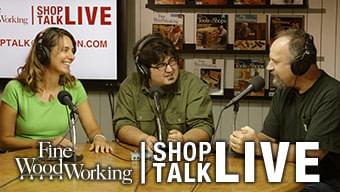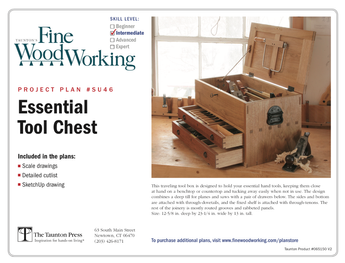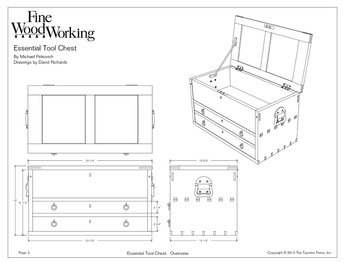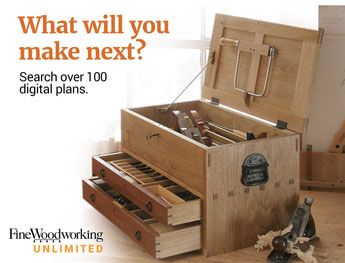I have a student who wants to measure down to the 1/64th of an inch when building his project. Is that necessary?
Discussion Forum
Get It All!
UNLIMITED Membership is like taking a master class in woodworking for less than $10 a month.
Start Your Free TrialCategories
Discussion Forum
Digital Plans Library
Member exclusive! – Plans for everyone – from beginners to experts – right at your fingertips.
Highlights
-
Shape Your Skills
when you sign up for our emails
This site is protected by reCAPTCHA and the Google Privacy Policy and Terms of Service apply. -
 Shop Talk Live Podcast
Shop Talk Live Podcast -
 Our favorite articles and videos
Our favorite articles and videos -
E-Learning Courses from Fine Woodworking
-
-
 Fine Woodworking New England Event
Fine Woodworking New England Event -












Replies
Interesting. Can he mark or cut that accurately is the bigger question. Likely he'll spend a larger part of his time "sneaking up on" that perfect cut.
I suppose that depends on the project. A framing carpenter nowadays would call a 1/4 good enough. And Elon would fire him if that's the best he can do. Personally I'm usually happy with a sixteenth. But there again it does depend on the project and 1/32 makes me happy.
In my current project (cabinets) I'm striving for 1/32. It's about as close as I can measure and I can reliable cut/plane etc. to that amount.
Thanks for the comments. I’m teaching a month long furniture making class at a small college in Maine. The class runs 4 days a week from 9am to 4pm. After 7-8 days of hands on instructional projects, they get to make something of their choice. The student in question is making a two drawer Shaker desk out of cherry.
Measure twice cut once.
It won't hurt him beyond slowing him down. Considering he's a student and assuming he's fairly new to the craft he'll learn the same lessons we all have... Where the number matters, where things just need to match up, and that when it looks right it usually is. He'll dispense with 64ths when they become difficult to see.
Yeah. I hear that. Wearing readers in the shop these days.
I believe that the runout on almost any machine manufactured for woodworking is at least 1/64 th. and that's the good ones. So to aim to be within a 64th will compensate somewhat for that error. Errors should average out across an entire project and not be relevant-except when they dont and show up in one place.( Like that fourth side on a mitered square that doesn't quite fit and needs adjustment.) A machinist to be off by 1/64 would be a huge mistake but the equipment they have available to them is far more accurate. I say why discourage someone from trying for perfection. Let him go for it. He will on his own figure out where it matters and where it doesnt.. if only to get him ready good at producing really sharp pencils.
If the student is measuring 1/64" where it doesn't matter at all (for example, the width or length of an overhanging table top, or the height of the table legs), it doesn't hurt but it should be explained to them that it really doesn't matter. If the student is measuring 1/64" when he/she should be using a much more accurate marking knife or mortise gauge instead, then it should be pointed out.
The amount of accuracy needed is clearly situational. As Badger says, might as well teach him about the different situations. If I want two or more things to be the same length, I use a stop block. I always try to be aware of situations where errors can accumulate. When I'm building furniture, I rarely think 1/16" is accurate enough; I'm typically wanting things within 1/32" or 1/64".
When setting up machinery, 1/64" is often way too coarse. I use a dial indicator and want to be within half a thousandth when setting planer or jointer knives. Being off on a mortise and tenon by 0.004" (the thickness of a piece of paper) makes the joint rattling loose. Don't have your tablesaw blade out of parallel from the fence or miter gauge slot by 1/64".
To me, it is also good for the student to aim for tight tolerances as practice for when it matters. I adopted that idea when I started learning woodworking. Everything I did I tried to do really well as practice for when it would matter.
As others have said, it kind of depends. I don't think that's unwarranted for joinery, although really you're going to fit the joint gradually anyway. But there are many dimensions, especially with larger parts, where the wood will twist or bend slightly and 1/64" will be academic. As someone else said, can't hurt for a beginner to learn this by doing, and starting with too precise might be better than the opposite.
There's a time and a place for precision... but at that point, I'd undoubtedly sneak cut or shave.
I go to 32nds for some things. You know, "between those 2 16ths," 64ths seem like a huge waste of time, not to mention impossible?... Considering a .9mm mechanical pencil is 2.3 times wider than a 64th of an inch....I'm not sure how anyone will pull that off reliably and without magnification lenses.
You can roll with the .3mm pencil, but you're going to be breaking so much lead trying to use that on wood, lol.
I hate measuring devices with anything more than 1/16” on them. If I have 1/16” graduations, I can go in the middle to get a 32nd. Rarely do I measure other than a few of the initial things on the piece. Beyond that, I am using a marking knife and making knife lines to get things to fit relatively to one another.
“ I believe that the runout on almost any machine manufactured for woodworking is at least 1/64 th.”
Respectfully disagree. I use my table saw for joinery that is darn near air tight. I agree that not all of our work requires this precision but your shop machines should certainly be capable of it.
Off topic.
Gorgeous work.
What did you finish the tiger maple with?
Expensive too, if no veneer was used.
@Bentusi - I used a method of shellac flooding. This can be problematic if you do not have a good relationship with shellac; some folks do not. I am not tooting my own horn. There are plenty of finishes I struggle with (read "am a bonehead") that others use with impunity. Shellac and I just happen to be friends ;-)
At any rate the shellac is applied . . . liberally . . . at about a 1-1/2 lb. cut. This allows the carrier (DNA) to soak into the softer tiger stripes and carry the shellac pretty deep creating a good contrast. Once dry this surface gets sanded off at 320 grit or so and then a top coat is applied (a 2lb. cut of shellac in this case).
The little wall cabinet is a take on Clark Kellogg's work and is solid material. I happened on this tiger material in the regular bin at the lumber yard and got off cheap. This is an occasional advantage to buying rough lumber ;-)
An interesting question of philosophy.
The student is missing the point of precision, which is to ensure that parts are interchangeable one with another; and of crafting an individual item, where it is possible and even more desirable for every joint to be individually fitted and tuned.
We simply do not require that level of measurement precision, especially given the eternally changing nature of wood as a material.
That said, it does no harm to try to do so, and it would be wrong I think to discourage it or even to sneer - instead allow them to try. They will probably succeed, but at a very slow pace and will soon see that their product is no better than a much less precisely measured one, and they will move on.
I have similar disdain for the use of dial and feeler gauges in the woodshop - I don't disagree that they have a role to play at times, but if you can't SEE the problem fairly easily, it's probably not relevant.
have you ever made a m&T center rail on a door or cabinet that leaves a 64th gap? I realize you can fill that, but it's pretty garish.
the measurement isn't the issue here, it's what it's being used for. I doubt it's a problem in a barn, but in fine work if it created a gap, it would be.
For me, I measure as close as I can get for the basic parts. Once those are cut to size, jointed, planed, etc. then I'm more concerned about fitting cross pieces, and internal parts to the piece. This means that what's important is that it all fits together, not whether the whole piece is off by 1/16" or 1/64".
There is a nice podcast episode on Shop Talk Live with Mike, Ben, and Vic talking about this space. Worth listening to: https://www.finewoodworking.com/2024/11/01/stl328-imperfect-precision
Do you really mean allow no more than 1/64” variance from the nominal target dimension? I try to achieve the most accuracy possible, but I usually target my nominal dimensions to multiples of 1/8”. It’s easier to see the lines on the tape measure. For example, why anyone would purposely work to 55/64” instead of 7/8” is beyond me.
That said, I regularly fabricate parts to within 1/64 (0.015625)” of target dimension. It’s easy to do and things fit together so much better.
I would just reiterate what I posted previoiusly concerning precision of 1/64".
"I measure as close as I can get for the basic parts. Once those are cut to size, jointed, planed, and dry fit I'm more concerned about fitting cross pieces and internal parts to the basic frame. This means that what's important is that everything fits together, not whether the whole piece is off by 1/16" or 1/64"."
So, the important thing is to make it all fit together and square. That may mean a series of cuts or planing strokes which get the piece to fit as precisely as possible regardless of precision of the measurement. With joints like half laps, mortise and tenons, dadoes, and rabbets, the highest priority is to get a fit as close to perfect as possible (tightly) when making furniture, cabinets, even small boxes. Sometimes that means that 1/64" might not be close enough when cutting joints on a router table but, again, it's fit not the precision of the cut.
This seems to be a difficult concept for people starting out in woodworking. The temptation is to cut all the parts to size to start so you can merely finish them up and assemble them.
The more productive concept to get the final desired product is to make everything fit, which means that parts are rough cut, then refined to fit within the piece being made. Learning that concept always produces better results than cutting everything to 1/64" "precisely" because measurement is a function the level of precision possible with the tools you have available (especially measuring tools), eyesight, and just the fact that humans aren't prerfect.
measure large dimensions to establish the scale of something, and then build everything else to fit.
if you use a cut list, I guess that doesn't work.
When I made a few infill planes, I wanted a fit within a thousandth or so. Anything bigger and you could see a gap. That could be filled with glue, but even on dark wood, you can see that, too. I'd bet some of my kitchen cabinet major dimensions (I made them) are off a 16th or more where they didn't matter.
I wouldn't want a guitar where any of the frets were off a 64th consistently!!